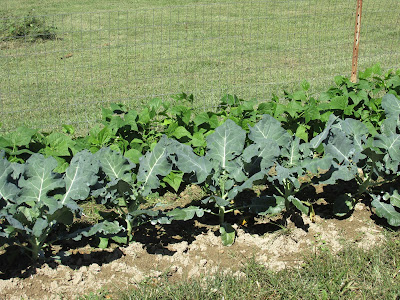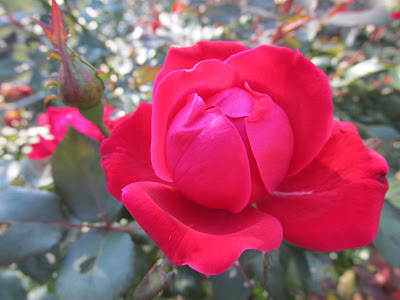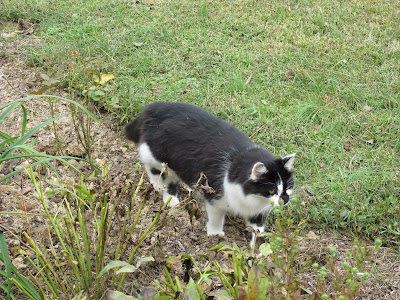October mornings are notably quiet, dawn-glow and sunrise slow to push away the darkness of night.
Mist hangs over the meadow.
We are balanced here on the dividing line between Central and Eastern time, choosing, as do most at this end of the county, to live on eastern time.
With curtains opened and blinds raised, I still need to switch on the overhead lights in the kitchen.
The cats clamour to go out, then hesitate on the front steps.
By mid-morning the mist has burned away and the sky is brilliantly blue.
The veg garden has been cleared and Jim has mowed all but the section where late crops are flourishing.
The broccoli is forming small heads, Napa cabbage is ready for salads, the green beans need picking every other day.
Dawn brings home tender small peas from the Dry Creek garden; Jim's late planted corn there is supplying a few ears. The last tomatoes are ripening on the west porch.
The clump of self-sown zinnias is still pretty from a distance, although a closer inspection proves they are tattered and fading.
I labored on four consecutive days this week to prepare my flower gardens for winter.
I started with the easiest and smallest of the plantings, very carefully tweaking out grass around the clematis vines, digging around the foxgloves and adding several more that spent the summer in the greenhouse.
The new garden at the west end of the house has been mostly successful, though the weeds have been a challenge. Most of the thyme plants along the raised edge and under the window have settled in. Several lavenders seem happy in the angle of the wall--you can see the flower heads against the logs. One lavender died--I don't know if it was one of those I grew from seed or a nursery purchase.
The brilliant Mexican sunflowers [Tithonia] have spilled wildly over the space allotted to them. Somewhere underneath that orange exuberance there is a smothered pink landscape rose and a clump of lemon balm.
The dwarf butterfly bush which I moved there has spread and flowered abundantly, crowding balloon flowers and nigella.
The twiggy stems of signet marigold, Lemon Gem, have gone brittle since this photo was taken earlier in the week.
I have grubbed out weeds around the three David Austin roses to the right of the walkway, stirred the dirt around the foxgloves, pruned the roses. There is still weeding and mulching to be done.
This is the original rough strip where plants moved from the farm were hastily interred two years ago.
It is a difficult spot to maintain. Pasture weeds constantly invade--the ground seems suitable for only robust plants.
Gooseneck loosestrife [Lysimachia] took over and had to be removed earlier in the summer. I noted that a few plants have reappeared. Daylilies do well here, also coneflower which defies weeds and insects to happily self-sow.
More work to be done here, some foxglove to set in, forking over the ground so laboriously weeded.
It will never be a tidy area, but the peonies are there, some iris, two varieties of shrub roses which I cherish.
Red Knock-Out Roses!
What would we do without them?
Tough, dependable, reviving after the mid-summer onslaughts of Japanese beetles, providing cheerful blooms til killing frost.
The roses have been troubled this year by these small green worms who can turn the leaves to lacy skeletons in short order.
I've not yet identified them, but they are surely a pestilence! I smash every one I find.
Foxglove, tucked among the miniature daylilies which front the Knock-out roses.
Blackberry lilies raised this season from seed. This was an interesting project. The seeds germinated slowly and at widely different intervals. In the end, I had 9 plants to set out in the new west garden. They are thriving.
An exotic coneflower grown from seed--at the moment I can't recall the variety.
Willis, in his 11th summer and feeling his age a bit, still loyally supervises my gardening activities.
Robert assisted my efforts in the rough perennial strip.
Edward [who is lazy] enjoys the warmth of the autumn sun on the stone path.
On Thursday, feeling the soreness and fatigue generated by four days of crawling about in the gardens, I took a break to do errands and some cooking.
Friday there were green beans for us to gather. More pruning!
It was something of a relief when the sky clouded over and a light rain began to fall late in the afternoon. The rain continued in desultory fashion today.
Jim declared a country drive was in order, so we puttered along winding back roads through a landscape that quite suddenly is colored with autumn hues of gold and russet.
I have watched as during the past two weeks a few trees along the south ravine and the pasture edges have begun to 'turn'--a branch of yellow leaves on the big sycamore, the dark gold of the hickories.
A scuffing of leaves lines the edges of the lane, more drift down with each stirring of the wind.
On Monday morning [5th Oct] a lone hummingbird drank at the feeder where several had darted the day before. By mid-morning, working in the strip of garden near the hanging feeders I noted that the busy little birds were no longer in residence--gone--until another spring.
I walked out late this afternoon, just before the early dusk, wearing my tall boots, sheltering my camera from the light drizzle.
I've been intrigued with these several trees in the hedgerow which I haven't identified. The purple leaves stand out among the yellow and golden russet of the others. I was surprised to see the clusters of red berries.
I am pleased with these 'Michaelmas daisies'--a variety called 'Raydon's Purple'. I bought one plant last year from a favorite mail order garden, hoped for more this spring, but they sold out quickly. The flowers are not quite identical to the New England Asters which grew in pastures and along roadsides in my native Vermont.
Nasturtiums straggle, become shabby, and yet they have marvelous powers of rejuvenation. Seeds from the spent blooms fall into soil of the pot and germinate. Clusters of fresh leaves and buds appear at the ends of drooping tendrils.
In a few weeks the frosts will come. Each season I cherish the last blooms, the October flowers, knowing that the joy of them must sustain me through the winter.
For all my grumbling over creaky knees and aching muscles, the labor of gardening is richly rewarded.



















I find your post so inspiring, as I seem to have neglected the garden this summer, and I can see a lot of work ahead of me in the spring!!
ReplyDeleteHildred; I am never caught up with the gardening! I start out with determination each spring. Then comes the heat and humidity of high summer when it is all I can do to -sort of--keep up with the veg garden. I find I constantly need the inspiration of other gardeners
DeleteCreaky knees and aching muscles - oh yes, aching bits from gardening v. familiar here this week too, only it was my hips and lower back mostly.
ReplyDeleteWhat a lovely round-up of your garden. Lots of colour and variety. We have Michaelmas Daisies here but I would never plant them again as they just want to lie down and spread everywhere! The new garden appears to have a lot fewer thugs in it, for which I will be very grateful! IF it becomes ours that is - many a slip 'twixt cup and lip . . .
Jennie; I thought it wise not to list all the 'bits' that ache! The Michaelmas daisies do sprawl, but I love them. I've had several more compact varieties, none of which seemed as hardy as these. I took the virtual tour again of the property where hopefully you will move--I do like the garden layout.
DeleteThe tree with the berries looks to be a dogwood.
ReplyDeleteTressa; Thank you! I went back and had a closer look at the tree--had forgotten that scraggly dogwood leaning through the larger trees along the edge of the north ravine. I take note of the dogwoods when they bloom and then they seem to fade into the 'under-story' of shrubbery.
DeleteThe Michaelmas daisies remind me of the asters out in the meadow here. Maybe they are closely related. Phil
ReplyDeletePhil; Michaelmas daisies and 'asters' are the same--I suppose I'm being a bit pretentious in preferring that term. I would love to have seeds or plants of the New England Aster. I once noticed this type of flower on roadsides in Ohio where they had a lighter lavender/pink color.
Delete